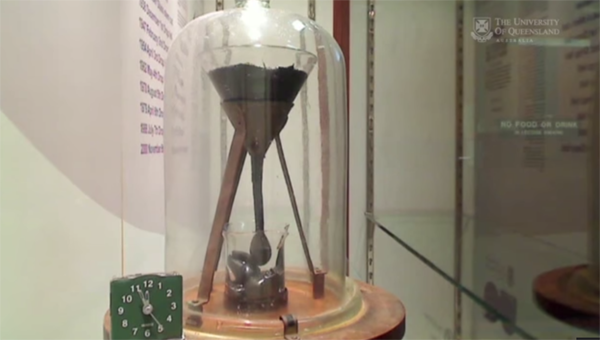Scientists at the University of Queensland in Australia have been watching a piece of pitch (tar) drip–very slowly–for 85 years. They’ve just had the ninth drop in that time, and the first captured on camera.
The pitch drop experiment was conceived in 1927 as an extreme way of demonstrating that a liquid could have such high viscosity that it misleadingly appeared to be a solid. It simply consists of some heated pitch in a funnel, covered by a glass dome. Over time drops form and then drop completely, around once every 10 years. As a sign of how long-term the experiment is, creator Professor Thomas Parnell let the pitch settle for three years before cutting the stem and allowing the first drop to start forming
Sadly the latest drop comes too late for Professor John Mainstone, who supervised the experiment for 50 years before his death last year. He missed drops in 1977 and 1988. By 2000 staff had added a webcam to increase the likelihood that somebody would, even if not in person, witness the drop as it happened. Amazingly not only did Mainstone miss the 2000 drop, but it occurred during a 20 minute outage in the webcam feed.
This week’s occurrence isn’t the conclusion of a complete cycle of an “official” drop. The ninth drop has now descended to the point where it is touching the pool formed by the previous drops. However, it hasn’t yet detached from the original piece of pitch.
There’s only been one occasion when the duration between drops shortened rather than lengthened. Despite the duration of the experiment, it’s currently too early to be certain if that’s an inherent quality of the pitch, or is affected by other factors such as temperature variation. The substantial increase in the intervals of the last two drops appears to be connected to the installation of air conditioning in the room housing the experiment in 1988.
This isn’t the first time pitch dropping has been caught on camera. Scientists at Trinity University in Dublin started a similar experiment in 1944 but later left the equipment unsupervised and unmonitored on a shelf where an unknown number of drops took place over the years. In April last year, staff decided to resume monitoring and installed a webcam, which caught a drop just three months later.

